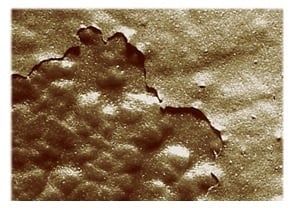Repairing Parylene Delamination
Posted by Sean Horn
Friday, April 21, 2017 7:37
@ 7:37 AM
Applied as a conformal coating through a unique chemical vapor deposition (CVD) process, parylene provides micron-thin, resilient barrier protection for an exceptional range of electrical assemblies. In comparison to liquid coatings — acrylic, epoxy, silicon, urethane — parylene is the coating-of-choice for protecting printed circuits boards (PCBs) and medical devices. It’s films negate the impact of gravity and surface tension during the coating process; .
With appropriate pre-treatment, CVD penetrates deep within substrate surfaces, rather than merely attaching to substrate exteriors, as liquid-application coatings do. Ultrathin protection negates operational dysfunction caused by excessive coating mass or viscosity, conditions that can impede assemblies’ performance. Parylene is chemically and biologically inert and stable, generating excellent barrier material to abrasive chemicals, bodily fluids, solvents, liquid water and water vapor. It is also readily adaptable for MEMs/nano technology.
Excellent but Not Flawless
 PCBs and like electronics can feature angular surfaces, crevices, exposed internal surfaces, pointed/sharp edges, or similar specialized assembly configurations; they are well-served by parylene’s all-inclusive conformal protection. While these features speak to parylene’s durability, reducing the need for repair and replacement, the coatings are not perfect. The potential for bridging, pinholes, puddling, run-off, sagging, or thin-out common to wet coatings is eliminated.
PCBs and like electronics can feature angular surfaces, crevices, exposed internal surfaces, pointed/sharp edges, or similar specialized assembly configurations; they are well-served by parylene’s all-inclusive conformal protection. While these features speak to parylene’s durability, reducing the need for repair and replacement, the coatings are not perfect. The potential for bridging, pinholes, puddling, run-off, sagging, or thin-out common to wet coatings is eliminated.
Durable and heat/liquid resistant, the coatings are difficult to rework, and occasionally require repair. Delamination, a lack of adhesion occurring when a conformal coating lifts away from the substrate, exposing the assembly’s workings, is a major parylene failure mechanism, necessitating repair.
Delamination and Parylene
Delamination results from faulty adhesion between the coating and substrate, producing a torn, unattached, and non-conformal coating. Separation from localized PCB regions is not necessary; even partial lifting of the parylene coating is sufficient to qualify as delamination. Since appropriate adhesion of conformal coatings is critical to their success, exposing even some fragment of the region to-be-protected negates their purpose and utility.
Delamination is frequently the result of:
- Surface contaminants on the substrate as parylene is applied.
- Poor parylene/substrate compatibility.
- Excess moisture on the substrate surface.
- Overly thick coating.
- Inadequate masking / demasking techniques.
Lifting the parylene film from the substrate, delamination leaves an unprotected area that may be subject to further coating peel-back and addition assembly exposure. Care must be taken both prior to and during CVD application procedures to assure subsequent delamination episodes do not occur.
Repairing Delaminated Parylene
Chemically resistant, parylene seldom responds to solvent removal; coated surfaces are resistant to most types of reworking. Parylene films are difficult to:
- mechanically compromise by chipping and related methods, or
- detach by thermal treatment due to melting/burning temperatures of 350°C+, which can exceed those of assembly components, rendering them inoperable.
Specialized techniques — micro-blast abrasion, laser ablation or plasma etching – successfully remove delaminated parylene coating. Perhaps even more effective is removal by mechanical incision, a costly, labor-intensive, and time-consuming method. Manually enacted, the treatment surface is cut by incisive tools, further lifting already separated film from substrate; the damaged parylene is then removed from the assembly with tweezers or similar implement. Because workers’ unprotected skin can contact the substrate surface during removal procedures, leaving bodily oils, sweat or like residue on the substrate, it is suggested operators wear protective gloves; otherwise, additional cleansing processes will be required, complicating the repair process, while adding to it’s expense.
In most instances, localized, spot removal is all that’s necessary; stripping the entire board is seldom required. Use of a soldering iron to carefully burn through the parylene is recommended in these cases, followed by touch-up with urethane or other liquid coating to tack down the parylene.
Regardless of the repair method, the goal is successfully stripping damaged parylene from the effected surface and restoring it, so assembly function can be maintained. Reworked/removed parylene can frequently be recoated to original specifications.
Prevention of Delamination
Prevention is the best cure. To lower the risks of delamination and the need for subsequent repair, ensure the following prior to CVD:
- Surface cleanliness removes all sources of substrate contamination – dirt, bodily substances, mold release agents, process residue. Otherwise, parylene vapor deposits over these agents, increasing the prospect of tearing in the contaminated area, which can spread along the coating’s surface. Surface cleanliness minimizes these conditions, while improving surface energy qualities.
- Materials compatibility coordinates parylene type with substrate material. Positive interaction of surface energies between coating/substrate materials supports reliable adhesion, minimizing delamination. Applying a primer material that bonds well with the substrate can help.
- Reduce coating thickness; thicker Parylene films tends to become brittle leading to instability and subsequent delamination.
- Use reliable masking methods to assure coverage of only designated PCB areas.
Post-production and inspection procedures must target the possibility of delamination, to limit its incidence.
To learn more about common parylene problems and how to prevent them, download our whitepaper now:
Download our Guide on Parylene
Comments
Homepage 4/17/2020. 10:17:10 AM
... [Trackback] [...] Informations on that Topic: blog.paryleneconformalcoating.com/whats-the-difference-between-potting-and-conformal-coating/ [...]

londondrugscanada.bigcartel.comlondon-drugs 4/17/2020. 10:17:10 AM
cialis uk https://londondrugscanada.bigcartel.com/london-drugs This is nicely expressed. !